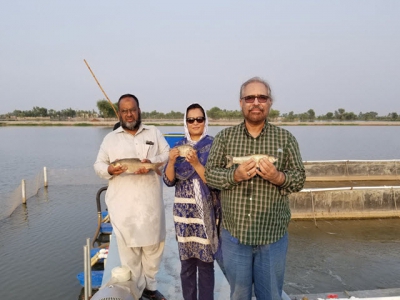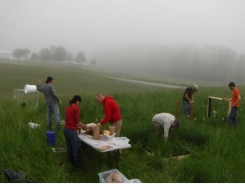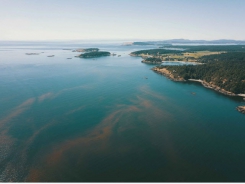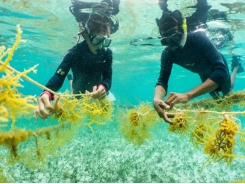In-pond raceway systems introduced in Pakistan

Modern strategy a game changer for industry
Team members of first the IPRS project in Pakistan, with sampled fish from the IPRS cells. Mr. Kamran Maqsood, Punjab Fish Farm (left); Dr. Shafaq Fatima, principal investigator, Department of Zoology, Lahore College for Women University (center); R.S.N. Janjua, consultant-IPRS, SoyPak (right).
Aquaculture in Pakistan is a fast-emerging sector that has developed over the last decade and has gradually evolved from extensive culture to semi-intensive farming. Lack of awareness of modern aquaculture techniques and floating aquafeeds had been the major impediments in the development of this sector. The vigorous efforts of the FEEDing Pakistan Program of the American Soybean Association (ASA) and the World Initiative for Human Health (WISHH) – funded by the U.S. Department of Agriculture (USDA) and implemented by SoyPak, Pvt. Ltd. from 2011 to 2018 – led to the introduction of floating, soy-based feeds in the country and to tilapia culture with the Fisheries Development Board (FDB) in Pakistan.
A baseline assessment of the Pakistani Aquaculture Industry was conducted in early 2012 by a three-member team of Dr. Kevin Fitzsimmons, Dr. John Woiwode, and Dr. R.S.N. Janjua, with recommendation of action supported by Drs. Johan Woiwode, Karen Veverica and Ram Bhujel. The major tangible outcome of this program was establishment of the first extruded aquafeed mill (2013) and tilapia hatchery (2014), which were milestones in the history of aquaculture industry of Pakistan.
Since these historic breakthroughs, the aquaculture industry has revolutionized and embraced modern technologies. In-pond raceway system (IPRS) technology is a very modern strategy in the aquaculture industry, combining the features and benefits of raceway technology, cage culture, recirculating aquaculture systems (RAS) and pond culture.
The IPRS technology was developed in 2006 at Auburn University to evaluate a commercial-scale unit at a catfish farm in western Alabama, USA. This technology was introduced and adopted in China (2013 to 2014) and in Vietnam (2016), and most recently in Mexico (2017), India and Egypt (2018). Pakistan is now the next destination of this revolutionary production technology. SoyPak (an IPRS and aquaculture consultancy firm in Pakistan) trained human resources from the aquaculture industry and academia in IPRS technology and has been closely involved and monitored the recent construction and operation of first IPRS in Pakistan.
In Pakistan, this innovative technology has been introduced for the first time in Southern Punjab by mutual collaboration of SoyPak, Pvt. Ltd., the Punjab Fish Farm, the Higher Education Commission of Pakistan and Lahore College for Women University. The Higher Education Commission of Pakistan has provided partial funds for the project, while Lahore College for Women University will carry out the scientific evaluation of fish growth and the effects of high stocking density on growth performance of fish in IPRS provided with ample aeration, constant water flow and improved feed management. The Punjab Fish Farm is interested to take the initiative to invest in the project.
IPRS technology: principles, components
The principle of the IPRS is to concentrate fish in raceways within a pond and provide them with constant water circulation to maintain optimal water quality and to improve feed management. The IPRS also has the potential to reduce solid waste loading in the pond by concentrating and removing it from the downstream end of raceway units. Water circulation, mixing and aeration are critical elements to this approach because they accelerate the assimilation of the organic loading of the pond from feeding the fish. Important components of IPRS are as follows:
- White-water units are the aerating and water mixing units attached to raceways and additional units are placed in the open pond to mix and circulate the water. Using air blowers or white-water air lift devices at the inlet end of the raceway, water is airlifted and moved to the raceway and released out at the other end and into the pond. White-water airlifts move and aerate water very well, with rates of aeration of up to 170 cubic meters per hour. This continuous mixing of water helps plankton production, improves the presence of beneficial bacteria, and accelerates the rate of waste load assimilation which cannot be achieved in traditionally managed commercial aquaculture ponds.
- A raceway with dimensions of 25 meters by 5 meters each and a depth of 2 meters is installed in a pond of 1 hectare and occupies about 2.5 percent of the total area. Fish are confined in raceways instead of being stocked in the total water area of a traditional pond.
- The IPRS technology can achieve 70 percent of nutrient collection from the raceways with the help of its sludge collection unit. The last 3 to 6 meters in length of the raceway or cell is used as the sludge collection point or the quiescent zone (QZ) at the extreme downstream portion of the raceway where fish are harvested, and solid wastes are collected and removed there. With the help of a sludge treatment plant, the waste can be reused as organic manure for crops.
- A baffle wall made from soil, fabric and fence is placed along the longitudinal axis at the center of the pond to force the water to take a long course around the pond before returning to the IPRS system head. It generates a riverine system/flow in the pond and helps in mixing of the pond water.
Benefits of IPRS for Pakistan
The following advantages can be achieved from IPRS technology in Pakistan:
- Improved fish production (75 to 150 kg per cubic meter).
- Reduced production cost per unit of fish produced (<30 to 35 percent).
- Improved feed conversion ratios (FCR: 1.00 to 1.4) and feeding efficiency.
- 100 percent fish harvest rate without discharge of water from the pond.
- Staggered stocking and harvest; culturing different species in different raceways, minimizing market-price risk.
- Easier fish health management and production operation – minimal use of drugs and chemical to ensure food security.
- 70 percent capture of nutrients in the form of feces, and for use as crop fertilizer.
- Zero water discharge for environmental protection and sustainability of natural resources. Water is only added to compensate for evaporative loss or seepage.
- Ecofriendly techniques.
- Harvest procedures and cost of labor for fish movement are simplified and greatly reduced.
- Efficient provision of animal protein to consumers.
Water and fisheries in Pakistan
An increasing shortage of water is an alarming situation for Pakistan. According to the International Monetary Fund (IMF), the country’s per capita annual water availability is 1,017 cubic meters, perilously close to the scarcity threshold of 1,000 cubic meters. Pakistan has the world’s fourth-highest rate of water use in agriculture, aquaculture and urbanization. Considering the high-risk water scarcity predicted by 2040, it is important to adopt technologies supporting water conservation in all fields, particularly agriculture and aquaculture.
In this scenario, IPRS is the most modern aquaculture technology providing solutions to water wastage and offers zero water discharge for three to four years when commonly practiced. Moreover, it can improve the per-unit area production of fish in Pakistan, thus optimizing the available resources of land and water and enhancing the industrially viable and profit potential for aquafarmers. Higher production per unit area will efficiently improve the return on IPRS investments, making the technology the best choice for progressive fish farmers and allied industries.
The production of Pakistan’s inland fisheries reached up to 185,000 metric tons (MT) in 2017 to 2018 (July to March) [Economic Survey of Pakistan (2018), Finance Division, Government of Pakistan]. According to the Food and Agriculture Organization’s (FAO) food balance sheet, Pakistan’s consumption of fish stands at 1.9 kg per capita per year (Needham and Funge-Smith, 2014; The consumption of fish and fish products in the Asia-Pacific region based on household surveys. FAO Regional Office for Asia and the Pacific, Bangkok, Thailand. RAP Publication 2015/12).
The IPRS technology is the most suitable answer to all these issues in Pakistan; and as a result, the first IPRS demonstration and commercial site was recently established at the Punjab Fish Farm in South Punjab, Pakistan, with the consultancy services of SoyPak.

Views of the construction of the first in-pond raceway system (IPRS) technology demonstration site in Pakistan, showing the floors of the raceways, concrete pillars and raceways walls.
Introduction of the IPRS technology
A number of initiatives are being undertaken by federal and provincial fisheries departments and the private sector. The current Prime Minister’s vision, “to promote fisheries and ensure food security through availability of quality products at competitive prices,” is opening new avenues for development of this sector. In this evolving time of industry, there was need of a technology that could address the major problems of the aquaculture industry of Pakistan including less production per unit area, high cost, inadequate FCR, water waste, poor aeration and water quality and risk to natural resources.
The inauguration ceremony of the first IPRS in Pakistan was held at the Farmers Field Day on August 4, 2019, in Khanewal, South Punjab. Senator Rana Mahmood Ul Hassan (Member of the Senate Standing Committee of Commerce and Textile) was the chief guest. He inaugurated the IPRS site and declared it a remarkable and history changing occasion for the aquaculture industry in Pakistan. The senator also hoped that other farmers would adopt this new and innovative technology. The Guest of Honor, Director General of Fisheries, Punjab, Dr. Sikender Hayat, recognized the IPRS team for their introduction of this technology in Pakistan.

Views of the raceways, quiescent zone (QZ) area and waste tanks.
The Representative of Higher Education Commission (HEC) of Pakistan, Tariq Aziz Chaudhary, introduced the objectives and targets of the Technology Development Fund and mentioned the historic struggle of institutions to bridge the gap between industry and academia. He also declared this technology a good development for the aquaculture industry of Pakistan and encouraged the innovative technology transfer project partially funded by the HEC. Several progressive fish farmers keenly participated in the event and appreciated the efforts of SoyPak to support the progress of the blue revolution in Pakistan. I, as a consultant to the project, gave a brief description of the components and benefits of the IPRS technology to participants and gave a tour of the IPRS demonstration site.
The system was built within a 3-hectare, traditional earthen pond with an average depth of 2.25 meters. The system, built as a fixed floor project, was installed on a poured concrete wall footing with pond liner bottoms, and consists of three raceways, each with dimensions 5 -by-22-by-2.25 meters (247.5 cubic meters raceway area). Water area was 5-by-22-by-2 meters (220 cubic meters raceway water volume). The total culture area of the raceways for holding and growing fish is 660 cubic meters, which represents 2.33 percent of the total surface area of the production pond. The raceways are equipped with five regenerative blowers of 1.6 kW horsepower. Additionally, the pond has three white-water units, jet and paddlewheel aerators installed in the open water area, which helps in mixing, accelerating and circulating water around the pond. A backup generator system has been provided to supply uninterrupted power supply to whole IPRS systems.
Fish fingerlings were first stocked during the second week of June 2019. The first raceway was stocked with 6,000 of grass carp (Ctenopharyngodon idella) fingerlings with an initial average weight of 70 grams per fingerling (stocking biomass of 1.75 kg per cubic meter of raceway volume). The second raceway was stocked with 8,000 rohu (Labeo rohita) fingerlings with an initial average weight of 300 grams per fingerling (stocking biomass of 10.90 kg per cubic meter of raceway volume). The third raceway was stocked with 16,500 GIFT tilapia (Oreochromis niloticus) fingerlings with an initial average weight of 32 grams per fingerling (stocking biomass of 2 kg per cubic meter of raceway volume). Expected harvest biomasses are 55 kg per cubic meter, 75 kg per cubic meter and 75 kg per cubic meter, respectively.

View of the first IPRS technology demo site in Pakistan.
Fish are initially being fed ad libitum with a 32 percent crude protein feed. The feeding protocol can be modified depending on temperature, growth and total biomass in each raceway as the production cycle progresses and the fish grow. Water parameters like dissolved oxygen, temperature, TDS and conductivity are regularly checked. Total body weight and length of the fish is checked on a monthly basis. Samples are collected from each raceway for proximate analysis and determination of the profile of fatty acids and amino acids, to assess the quality of the fish meat and fish growth. As stocking density per cubic meter is much higher compared to traditional farming practices, the effects of crowding stress on fish physiology and growth are being studied.
Perspectives
The introduction of the IPRS technology in Pakistan will be a historic step in the blue revolution in the country. Since the launch of the demonstration site, fish farmers and public departments have been keen to learn the design, benefits and expected harvesting biomass. It is hoped that this technology will soon be adopted by other progressive farmers and will make the future of aquaculture in Pakistan brighter, providing low-cost animal protein in the form of fish at the table of every consumer, to contribute in addressing the malnutrition in Pakistan.
Related news
Tools

Phối trộn thức ăn chăn nuôi

Pha dung dịch thủy canh

Định mức cho tôm ăn

Phối trộn phân bón NPK

Xác định tỷ lệ tôm sống

Chuyển đổi đơn vị phân bón

Xác định công suất sục khí

Chuyển đổi đơn vị tôm

Tính diện tích nhà kính

Tính thể tích ao




 Solar dryer dome technology solution enhance climate change…
Solar dryer dome technology solution enhance climate change…  Restorative aquaculture: can farming shellfish and seaweed provide…
Restorative aquaculture: can farming shellfish and seaweed provide…